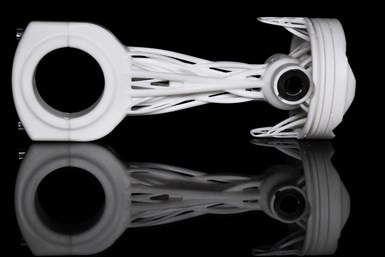XJet Produces First Entirely Ceramic Piston for Chaos Ultracar
Company says no other technology could achieve the accuracy and complexity required to create Spyros Panopoulos Automotive’s lightweight ceramic design.
Share
Read Next

The Chaos Ultracar ceramic piston and rod. Photo Credit: XJet
XJet has produced the world’s first additively manufactured car engine piston made entirely with ceramic for Spyros Panopoulos Automotive (SPA), which developed the part for its Chaos Ultracar.
Spyros Panopoulos is the SPA founder and man behind what the company says is the most efficient combustion engine on the planet — pursuing speeds of over 500 kph with acceleration from 0 to 100 kph in 1.55 seconds for the Chaos, which is currently in development. According to the company, it has the fastest revving production car engine ever seen, reaching up to 12,200 rpm and 3,065 hp.
To make the engine a reality and support the extreme levels of performance required, the company designed the “anadiaplasi” piston. It was created using a method of design for additive manufacturing (AM) in which a component takes its shape based on the forces acting on it. Material is minimized where it doesn’t support performance and added where reinforcement is needed, thereby optimizing weight while maintaining the strength and temperature resistance of the part — which is essential for any piston, but particularly testing in such a high-performing engine. The company says the result is an organic complex shape that is light, yet strong, based on a technique that is implemented throughout the Chaos Ultracar.
On concluding the design, Panopolous realized that to produce such complex geometry — along with the high accuracy and excellent surface finish required — the only relevant manufacturing technology was AM and, in particular, Xjet’s nanoparticle jetting. Working in collaboration with Lino 3D (XJet’s business partners in Greece), SPA selected XJet Alumina material for the Chaos piston due to its strength, hardness, light weight and almost total resistance to thermal expansion, which is an important characteristic for the part.
“Ceramic offers many advantages compared to other materials,” Panopolous says. “Harder and stiffer than steel, more resistant to heat and corrosion than metals or polymers and weighing significantly less than most metals and alloys, XJet’s alumina parts will withstand the high temperatures expected to develop within the combustion chamber as well as on the fast-moving parts.”
Panopolous says that XJet systems are uniquely capable of producing this part in ceramic, and there’s absolutely no room for error in this project. An advocate for AM, Panopolous is putting it to use throughout the Chaos Ultracar with a reported 78% of the body being 3D printed as well as other crucial elements such as the engine block, camshaft and intake valves.
“We are proud to be using such progressive technology in our Ultracar,” Panopolous adds. “Our projects push performance to the extreme and so we are extremely selective about the materials and technologies we use. I believe this is the first time ceramic AM is being used in motorsport.”
Related Content
-
What We Found at Formnext 2023
New metal processes, new possibilities for existing processes, the next step for copper and more. Here is a summary drawing on all our reporting from November’s event.
-
3D Printed Reactor Core Makes Solar Fuel Production More Efficient
The solar reactor uses water and CO2 from the air and sunlight as the energy source to produce carbon-neutral liquid fuels, for example, solar kerosene for aviation.
-
Video: AM for Harder, Longer-Lasting Brake Discs
Additive manufacturing is being applied to limit automotive brake dust. For a major automaker, Etxetar and Talens are developing a production-speed directed energy deposition system to give brake discs a precise layer of wear-resistant carbide.













